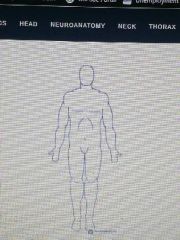![]()
![]()
![]()
Use LEFT and RIGHT arrow keys to navigate between flashcards;
Use UP and DOWN arrow keys to flip the card;
H to show hint;
A reads text to speech;
48 Cards in this Set
- Front
- Back
- 3rd side (hint)
|
Anatomy |
Study of body structure |
|
|
|
Physiology |
Study of how the body functions |
F |
|
|
Pathophysiology |
Study of disorders of functioning |
Dis of F |
|
|
Anatomical position |
The body is standing erect with arms at the sides and Palms turn forward |

|
|
|
Body planes |
An imaginary flat surface that divides the body into sections |
|
|
|
Frontal |
(Coronal) vertical planes
Line from head to toe that divides the body into front and back parts |

|
|
|
Sagittal Plane |
Vertical plane Lengthwise divides the body into right and left sides |

|
|
|
Transverse Plane |
Horizontal plane Divides body into upper and lower parts |

|
|
|
Body Positions/Directions |
Superior(higher) and Inferior (lower) Medial/Midline (middle) Lateral (side) Proximal (nearest) and Distal (distant) Supire (lying on back)/ Prone (lying on stomach) |
|
|
|
Body Cavities (2 groups) |
1. Dorsal: divided into cranial and spinal cavities. (brain and spinal cord) 2. Ventral: divided into thoracic and abdominal cavities. |
|
|
|
Date and purpose of PT Law |
1969 the PT Law was established by the state legislature. Ensure quality of care for the patients. |
|
|
|
Legal Definition of PT |
treatment and rehabilitation of mentally ill, emotionally disturbed or mentally retarded |
|
|
|
Qualifications to apply for examination |
18 years old high school or GED complete course of study by accredited school |
|
|
|
Board may revoke license |
unprofessional conduct |
|
|
|
Ethics |
an accepted code of conduct. cannot act unprofessionally. |
|
|
|
WHO |
World Health Organization - the state of complete physical, mental and social well-being and not merely the absence of disease. |
|
|
|
Views, issues and trends in health care system |
People are more informed managed care systems health education important/promoting wellness |
|
|
|
2 major goals of human system |
1. Homeostasis: equilibrium and balance 2. Live in harmony with the external environment. |
|
|
|
Wellness |
maintain balance while adapting to factors that can upset it. |
|
|
|
HCW and role |
Health Care Worker encourages patient to improve their health |
|
|
|
Holistic Approach |
treating whole person in total functioning |
TF |
|
|
Role of Stress in illness |
wear and tear on the body |
|
|
|
Stressor |
factor that disturbs body's equilibrium |
|
|
|
GAS |
General Adaptation Syndrome by Hans Selye |
|
|
|
Adaptation |
a person's responds to stress |
How do they react |
|
|
3 Stages of GAS |
1. Alarm Reaction 2. Stage of Resistance 3. Stage of Exhaustion |
|
|
|
Alarm Reaction |
body gets ready for instant action. Fight or flight. all body functions increase |
|
|
|
Stage of Resistance |
Most active battle for equilibrium body may stabilize and return to normal |
|
|
|
Stage of Exhaustion |
if stressor is severe ,it depletes the resources of adaptation. body cant resist the stress, energy is gone and death can occur. |
|
|
|
Maslow's Hierarchy of Needs Theory |
All needs are ranked based on survival.
All humans have basic needs that must be met to some degree. |
|
|
|
Maslow's Rankings (5) |
1.Physiologic (Physical)(most influential for survival) 2. Security and Safety 3. Love, affection and belonging 4. Self-Esteem 5. Self-Actualization |
|
|
|
Psycho-social Aspects of care |
focus on ability not disability |
|
|
|
Therapeutic Relationship |
one that promotes healing |
Pro he |
|
|
Expectation of patient |
what is happening to them has a greater in their behavior |
|
|
|
Definition of Nursing |
ANA - the diagnosis and treatment of human responses to actual and/or potential health problems |
|
|
|
Incident Report |
any unusual occurrence at a facility |
|
|
|
Good Samaritan |
law that protects you from a liability if you give emergency care within the limits of first aid and if you act in a reasonable and prudent manner. |
|
|
|
Nephritis |
inflammation of the kydneys |
|
|
|
Polyuria |
excessive production of urine |
|
|
|
Hematemesis |
vomiting of blood |
|
|
|
Assault |
either a threat or an attempt to injure in an illegal manner |
|
|
|
Battery |
unlawful touching of another person without his consent, with or without resultant injury |
|
|
|
Consent |
Permission granted by a person voluntarily and in his right mind. Written consent is safer |
|
|
|
Licensure |
authorization by the state to practice one's profession or vocation |
|
|
|
Malpractice |
proffessional care that has led to injury, due to faulty practice |
F.P. |
|
|
Negligence |
failure to perform in a reasonably prudent manner |
P.M. |
|
|
Standard of Care |
Performing duties in an expected manner |
E.M. |
|
|
Invasion of Privacy |
a civil wrong that unlawfully makes public knowledge of any private or personal info without the consent of the wronged person |
|

